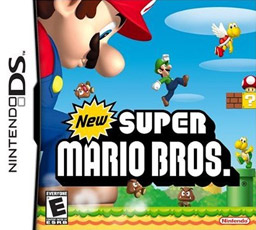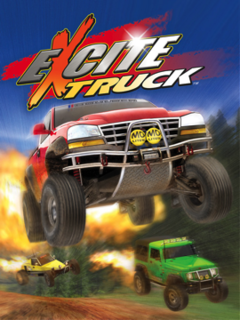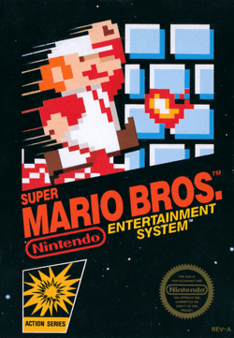Mario Kart is a series of go-kart racing video games developed and published by Nintendo, as a spin-off from its flagship Super Mario series. Its characters include those from the Mario, The Legend of Zelda, Animal Crossing, and Splatoon series, competing in races while using various items to gain advantage.

Super Mario Kart is a 1992 kart racing video game developed and published by Nintendo for the Super Nintendo Entertainment System video game console. The first game of the Mario Kart series, it was released in Japan and North America in 1992, and in Europe the following year in 1993. Selling 8.76 million copies worldwide, the game went on to become the fourth best selling SNES game of all time. Super Mario Kart was re-released on the Wii's Virtual Console in 2009, and on the Wii U's Virtual Console in 2013. Nintendo re-released Super Mario Kart in the United States in September 2017 as part of the company's Super NES Classic Edition.

Yoshi is a fictional dinosaur who appears in video games published by Nintendo. Yoshi debuted in Super Mario World (1990) on the Super Nintendo Entertainment System as Mario and Luigi's sidekick. Yoshi later starred in platform and puzzle games, including Super Mario World 2: Yoshi's Island, Yoshi's Story, Yoshi's Woolly World, and Yoshi's Crafted World. Yoshi also appears in many of the Mario spin-off games, including Mario Party and Mario Kart, various Mario sports games, and Nintendo's crossover fighting game series Super Smash Bros. Yoshi belongs to the species of the same name, which is characterized by their variety of colors.

Super Mario World 2: Yoshi's Island is a 1995 platform game developed and published by Nintendo for the Super Nintendo Entertainment System (SNES). To reunite baby Mario with his brother Luigi, who has been kidnapped by Kamek, the player controls Yoshi, a friendly dinosaur, through 48 levels while carrying Baby Mario. As a Super Mario series platformer, Yoshi runs and jumps to reach the end of the level while solving puzzles and collecting items. In a style new to the series, the game has a hand-drawn aesthetic and is the first to have Yoshi as its main character. The game introduces his signature abilities to flutter jump and produce eggs from swallowed enemies.

Tetris Attack, also known as Panel de Pon, is a 1995 puzzle video game developed by Intelligent Systems and published by Nintendo for the Super Nintendo Entertainment System. A Game Boy version was released a year later. In the game, the player must arrange matching colored blocks in vertical or horizontal rows to clear them. The blocks steadily rise towards the top of the playfield, with new blocks being added at the bottom. Several gameplay modes are present, including a time attack and multiplayer mode.
Mario Party is a party video game series featuring characters from the Mario franchise in which up to four local players or computer-controlled characters compete in a board game interspersed with minigames. The games are currently developed by NDcube and published by Nintendo, being previously developed by Hudson Soft. The series is known for its party game elements, including the often unpredictable multiplayer modes that allow play with up to four, and sometimes eight, human players or CPUs.

Mach Rider is a futuristic vehicular combat video game created by Nintendo. It was first released in Japan in 1985 for the Nintendo Family Computer, and then in North America a year later for the Nintendo Entertainment System, and in 1987 for the PAL region. Later it was released on the Virtual Console for the Wii (2007), Nintendo 3DS (2013) and Wii U (2014).

Kirby Super Star, released as Kirby's Fun Pak in PAL regions, is a 1996 platforming video game developed by HAL Laboratory and published by Nintendo for the Super Nintendo Entertainment System, part of the Kirby series of platforming video games by HAL Laboratory. The game was advertised as featuring eight games: seven short subsections with the same basic gameplay, and two minigames.

Lakitu, known in Japan as Jugem, is a fictional flying Koopa in the Mario franchise. Created by Shigeru Miyamoto, he first appeared in the Nintendo Entertainment System video game Super Mario Bros., where he dropped enemies called Spinies on the stage. He has a striped green shell, wears aviator goggles, and rides around in a smiling cloud. He has since appeared in several main Mario titles since, as well as Mario spin-off titles, notably the Mario Kart series where he acts as the referee and a playable character in Mario Kart 7, Mario Kart 8 and Mario Kart Tour. He has appeared in non-Mario titles, including the Super Smash Bros. series as an assist trophy in Super Smash Bros. Brawl, and in Super Smash Bros. for Nintendo 3DS and Wii U.

New Super Mario Bros. is a platform video game in the New Super Mario Bros. series developed by Nintendo for the Nintendo DS. It was first released in May 2006 in North America and Japan and in PAL regions the following month. It is a part of the New Super Mario Bros. subseries of the Super Mario franchise, and follows Mario as he fights his way through Bowser's henchmen to rescue Princess Peach. Mario has access to several power-ups that help him complete his quest, including the Super Mushroom, the Fire Flower, and the Super Star, each giving him unique abilities. While traveling through eight worlds with a total of 80 levels, Mario must defeat Bowser Jr. and Bowser before saving Princess Peach.
A*mazing was an Australian children's television game show that aired between 16 May 1994 until 1998 on the Seven Network. It was famous for a relatively large and elaborate maze/obstacle course that was part of the show's studio set. A*mazing was hosted by James Sherry for the entire run of the series. A*mazing was produced at Channel 7 in Brisbane from 1994–1996 and then at Channel 7 in Perth from 1997–1998.

Excite Truck is a video game published by Nintendo and developed by Monster Games for the Wii video game system. It features malleable environments and tilt-based controls. The game was one of the Wii launch titles in North America. It is the third main game in the Excite series and the first to feature vehicles other than motorbikes. Excitebike was released on the Virtual Console service in Europe on February 16, to mark the European release of Excite Truck.

Super Mario is a platform game series created by Nintendo based on Mario. Alternatively called the Super Mario Bros. series or simply the Mario series, it is the central series of the greater Mario franchise. At least one Super Mario game has been released for every major Nintendo video game console. Many Super Mario video games are on non-Nintendo platforms. There are twenty-one similar games and one cross-series game that may or may not be included as part of the series.
Donkey Kong is a video game franchise, starring a gorilla named Donkey Kong created by Shigeru Miyamoto in 1981. The franchise consists mainly of two game genres, plus spin-offs of various genres.

Wario is a video game franchise, a spin-off of the Mario series. It comprises various video games created by Nintendo, starring the character Wario. The franchise began with Wario Land: Super Mario Land 3, the first game to feature Wario as a playable character. The Wario series includes mostly platforming video games and minigame compilations, but also includes other genres.

Mario is a media franchise, published and produced by video game company Nintendo, created by Japanese game designer Shigeru Miyamoto and starring the fictional character Mario. It is primarily a video game franchise, but has extended to other forms of media, including television series, comic books, a 1993 feature film and theme park attractions. The series' first installment was 1983's Mario Bros., although Mario had made his first appearance in 1981's Donkey Kong, and had already been featured in several games of the Donkey Kong and Game & Watch series. The Mario games have been developed by a variety of developers including Nintendo, Hudson Soft, and AlphaDream. Most Mario games have been released exclusively for Nintendo's various video game consoles and handhelds, from the third generation onward.
Nintendo Campus Challenge was a video game competition sponsored by Nintendo and held at nearly 60 college campuses and other events throughout the United States, including a Canadian Tour. There were two Campus Challenge events, one in 1991 and another in 1992.

Pit is a fictional character and the protagonist of the Kid Icarus series. Debuting in Kid Icarus for the Nintendo Entertainment System in 1986, Pit would later appear in Kid Icarus: Of Myths and Monsters for the Game Boy in 1991, and Kid Icarus: Uprising for the Nintendo 3DS in 2012.

Super Mario Bros. is a platform game developed and published by Nintendo. The successor to the 1983 arcade game Mario Bros. and the first in the Super Mario series, it was released in 1985 for the Famicom in Japan. Following a limited US release for the Nintendo Entertainment System (NES) in late 1985, the Vs. Super Mario Bros. arcade game port for the Nintendo Vs. System received a wide international release for overseas markets outside of Japan in early 1986, before the NES version received a wide release in North America the same year and in PAL regions in 1987. Players control Mario, or his brother Luigi in the multiplayer mode, as they travel the Mushroom Kingdom to rescue Princess Toadstool from Bowser. They must traverse side-scrolling stages while avoiding hazards such as enemies and pits with the aid of power-ups such as the Super Mushroom, Fire Flower and Starman.

Super Mario Party is a party video game developed by NDcube and published by Nintendo for the Nintendo Switch. The eleventh main instalment in the Mario Party series, this game was described as a "complete refresh" of the franchise, bringing back and revitalizing gameplay elements from older titles while also introducing new ones to go along with them. It was released worldwide on 5 October 2018 and sold 1.5 million copies by the end of the month. As of July 2021, the game has sold more than 15.72 million copies worldwide, making it one of the top ten best-selling games on the system. A follow up title for the Nintendo Switch, Mario Party Superstars, is planned for release in 2021.














